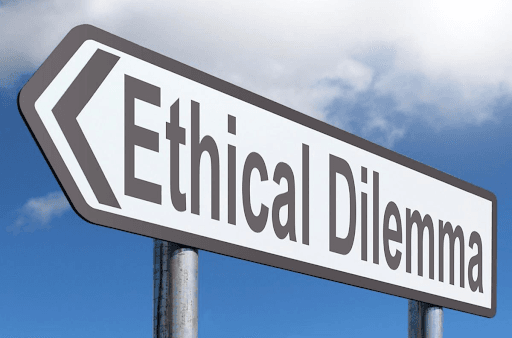
Source [Picpedia] (https://www.picpedia.org/highway-signs/images/ethical-dilemma.jpg)
Decisions about moral dilemmas can seem highly subjective and driven largely by emotion. However, research and various models of ethical decision-making support the idea that moral decisions can be objective, consciously or subconsciously. Jones’s 1991 model of moral intensity, also known as ethical intensity, was the first framework to acknowledge factors aside from situational or individual characteristics of the person making the decision. His model suggests that people instead make ethical decisions based on six factors of the moral issue:
- The magnitude of consequences
- Social consensus
- The probability of effect
- Temporal immediacy
- Proximity
- Concentration of effect
Later research, including by Goles’s team in 2006 and Lincoln and Holmes in 2011, shows that people use these factors in various industries and situations, such as marketing, the military, and information systems.
Moral issues and moral agents
Moral issues are situations in which a person’s actions or decisions may harm or benefit other people. Moral agents are the people making decisions about the issue, who must understand that they have a choice in order to make a moral judgment. Jones refers to Fiske and Taylor’s book “Social Cognition” when writing that people are more likely to recognize moral issues when they tend to investigate psychological threats rather than avoid them, and he refers to a study by Rothbart’s team in 1978 when he writes that people also tend to recognize moral issues when there is a higher magnitude of consequences.
Magnitude of consequences
The magnitude of consequences is the total harm or benefit that would result from a decision on a moral issue. For example, a decision that causes deaths would have a higher magnitude of consequences than one that causes non-fatal injuries; a decision that causes a monetary gain of five thousand dollars has a higher magnitude of consequences than a decision that causes a gain of fifty dollars; and a decision that affects several people would have a higher magnitude of consequences than one that affects a single person. Although Jones notes that the magnitude of consequences must reach a high threshold before people recognize a moral issue, he refers to a 1983 study by Fritzsche and Becker that shows that people are more likely to make ethical choices when faced with a higher magnitude of consequences.
Social consensus
The social consensus of a moral issue is a society’s general opinion regarding the ethics of a given decision. For example, people are less likely to harm an animal if their society values animal welfare. According to Jones, this is both because social consensus takes away the guesswork about the ethics of a decision and gives the moral agent external support for their decision. The study by Lincoln and Holmes also demonstrates that in order for the moral agent to feel comfortable making an unethical choice, the social consensus does not have to point to unethical choices–it only has to weaken its stance on the ethical choice.
Probability of effect
The probability of effect is twofold: first, it is the probability that a moral decision will have the expected effect, and second, that the effect will result in the expected consequences. For example, when selling a car that is unsafe in a particular type of crash, there is both the probability that that crash will occur and the probability that the crash will result in the expected injuries to the passengers.
Temporal immediacy
Temporal immediacy relates to the amount of time between the moral decision and the effects of that decision. Effects that happen sooner have higher temporal immediacy than effects that take longer. People tend to make more ethical decisions when temporal immediacy is high because people in general tend to place more weight on events that will happen now or soon than those that will happen in the future. Moral agents may also assume that future effects have time for other influences to intervene and prevent the harm from occurring.
Proximity
Jones defines the proximity of a moral issue as how close the moral agent is to the issue or its effects, whether social, cultural, psychological, or physical. For example, military officers may place less weight on harm that will occur in their own country or to their own squadrons than harm that will occur overseas or to other squadrons. Lincoln and Holmes’s paper also states that the closer the moral agent is to an issue or its consequences, the more likely they are to be aware of the moral issue and the harm or benefit that might arise. Jones states that each of the proximity types above has their own unique effects, but he grouped them together in this model for the sake of simplicity and their similarities.
Concentration of effect
This is the only factor that has an inverse relationship with morality. The more concentrated the harm, the less ethical the situation, as long as the magnitude of consequences is the same. For example, stealing fifty dollars from one person is less ethical than stealing one dollar from fifty people. In the latter case, the same amount of harm is diffused over a large number of people. As a fictional example of this concentrated harm, Jones points to Ursula K. Le Guin’s 1975 short story “The Ones Who Walk Away from Omelas,” in which a great number of people live in a utopia at the expense of one deeply suffering person.
Relationships between the factors
Jones suggests that these factors act together to affect moral intensity: all of the six factors have to reach a “threshold” before moral intensity becomes significant, and the components also have “interactive effects.” A 2006 study by McMahon and Harvey even suggests that magnitude of consequences, probability of effect, and temporal immediacy may all be a result of the same factor, which in their 2007 study they refer to as “probable magnitude of consequences.” The study by Lincoln and Holmes also shows a strong association between magnitude of consequences and the probability of effect.
Support for the six factors
Since Jones presented the model of moral intensity, many studies have examined the influence of each of the six factors on moral decision-making. The results are mixed. In the decade after Jones presented his model, research such as a 1997 study by Harrington’s team and a 2002 study by Carlson’s team strongly supported that both magnitude of consequences and social consensus have an effect.
The studies by McMahon and Harvey in 2007 and Lincoln and Holmes in 2011 both support the influence of social consensus. Lincoln and Holmes found that social consensus “is significantly associated with moral awareness, judgment, and intention” and that moral agents are influenced by what they perceive that the rest of their social group considers right or wrong, which is in line with previous studies. One study by Tsalikis’s team in 2008 found no association between social consensus and their participants’ moral decisions, and because of the study’s demographics, the authors state that this might indicate cultural differences.
Although McMahon and Harvey’s 2007 study found that magnitude of consequences, probability of effect, and temporal immediacy have a significant effect when combined, Lincoln and Holmes’s research shows that temporal immediacy on its own doesn’t have much influence over a person’s moral decisions and is “a weak predictor of moral intention.” This contrasts with Tsalikis’s study, which found that temporal immediacy is among the three most influential factors.
Lincoln and Holmes’s study supports that probability of effect is an influential factor and a predictor “for moral judgment and intention,” both on its own and when combined with the magnitude of consequences. Tsalikis’s study shows that the probability of effect on its own is an influential factor of moral intensity.
Unfortunately, both McMahon and Harvey’s 2007 study and Lincoln and Holmes’s study found little relationship between proximity and ethical behavior. And despite the vivid depictions in Le Guin’s “The Ones Who Walk Away From Omelas,” both Tsalikis and Lincoln and Holmes also found little evidence that concentration of effect is a determining factor in moral decision-making.
Conclusion
Although evidence for this model is mixed, the model can provide a framework for thinking about the characteristics of moral issues. It allows decision-makers to assess an issue more objectively and see the issue from multiple angles, which can help both the moral agent and someone coaching a moral agent through a tough decision. It can also help people understand the decisions that other moral agents make or are considering making so that they can assess situations together, possibly leading to compromise and conflict resolution.
